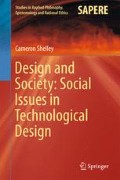Abstract
A social contract defines a body of rights that people respect in order to share resources and collaborate in a mutually beneficial way. Sometimes, social contracts are embodied explicitly in laws. However, social contracts are often implicit and may originate from many sources. One such source is designs themselves, whose designers have particular views about the social arrangements that people should operate under. Recall that Dieter Rams thought that designers should aim to bring about a humane world. Such views are often embodied in design movements that suggest an ideal world that designers should attempt to foster in their work. Modernism, as noted earlier, suggests that there is a universal, industrial lifestyle that good design should tend towards. Ideals like this may be called social agendas. A social agenda is not a set of cultural expectations that designs may satisfy but an ideal that designs promote for people to follow. Several examples of social agendas in design are discussed, but the list is open-ended.
Access this chapter
Tax calculation will be finalised at checkout
Purchases are for personal use only
Notes
- 1.
Julier (2008), p. 75.
- 2.
Quoted in Julier (2008), p. 76.
- 3.
Forty (1986).
- 4.
Forty (1986), pp. 65–66.
- 5.
Forty (1986), pp. 207ff.
- 6.
Forty (1986), pp. 216–217.
- 7.
Vanek (1975).
- 8.
Rosenfeld (1999), p. 48.
- 9.
Hoffman (1999), p. 7.
- 10.
Rees (2013).
- 11.
Cf. Wansink (2013).
- 12.
Cf. Crawford (2015).
- 13.
Hales (2002).
- 14.
Lidwell and Mancasa (2009), pp. 54–55.
- 15.
Guinness World Records (2006).
- 16.
Dunaway (2015), pp. 79–95.
- 17.
Deterding et al. (2011).
- 18.
Volkswagen (2009).
- 19.
Morozov (2013).
- 20.
Packer (2013).
- 21.
Ungerleider (2015).
- 22.
Saval (2014), pp. 45ff.
References
Crawford, M. (2015). The world beyond your head: On becoming an individual in an age of distraction. New York: Farrar, Straus and Giroux.
Deterding, S., Dixon, D., Khaled, R., & Nacke, L. (2011). From game design elements to gamefulness: defining “gamification”. Proceedings of the 15th International Academic MindTrek Conference: Envisioning Future Media Environments (pp. 9–15). New York: ACM.
Dunaway, F. (2015). Seeing green: The use and abuse of American environmental images. Chicago: University of Chicago Press.
Forty, A. (1986). Objects of desire: Design and society since 1750. London: Thames and Hudson.
Galloway, L. (1919). Office management: Its principles and practice. New York: The Ronald Press Company.
Guinness World Records. (2006, Sep 1). Pen—best selling. Retrieved Feb 1, 2016, from Guiness World Records: http://www.guinnessworldrecords.com/world-records/pen-best-selling/
Hales, L. (2002, Sep 28). Throw old stuff away! New ads deride attachment to worn-out things. Washington Post.
Hoffman, J. S. (1999). Appliances, energy, and the environment: The scale of the issue. In P. Bertoldi, A. Ricci, & B. H. Wajer (Eds.), Energy efficiency in household appliances (pp. 7–13). Berlin: Springer.
Julier, G. (2008). The culture of design (2nd ed.). London: SAGE.
Lidwell, W., & Mancasa, G. (2009). Deconstructing product design. Beverly, MA: Rockport.
Morozov, E. (2013). To save everything, click here: The folly of technological solutionism. New York: Public Affairs.
Packer, G. (2013, May 27). Change the world: Silicon Valley transfers its slogans—and it’s money—to the realm of politics. Retrieved Oct 2, 2015, from The New Yorker: http://www.newyorker.com/magazine/2013/05/27/change-the-world
Rees, J. (2013, Oct 4). The huge chill: Why are American refrigerators so big? Retrieved Oct 1, 2015, from The Atlantic: http://www.theatlantic.com/technology/archive/2013/10/the-huge-chill-why-are-american-refrigerators-so-big/280275/
Rosenfeld, A. H. (1999). The art of energy efficiency: Protecting the environment with better technology. Annual Review of Energy and the Environment, 24, 33–82.
Saval, N. (2014). Cubed: A secret history of the workplace. New York: Doubleday.
Ungerleider, N. (2015, April 15). Waze is driving into city hall. Retrieved May 20, 2015, from Fast Company: http://www.fastcompany.com/3045080/waze-is-driving-into-city-hall
Vanek, J. (1975, Nov 1). Time spent in housework. Scientific American, 116–120.
Volkswagen. (2009, Sep 21). The world’s deepest bin: The fun theory. Retrieved Feb 2, 2016, from TheFunTheory.com: http://www.thefuntheory.com/worlds-deepest-bin
Wansink, B. (2013). Slim by design: Mindless eating solutions for everyday life. New York: William Morrow.
Author information
Authors and Affiliations
Corresponding author
Rights and permissions
Copyright information
© 2017 Springer International Publishing AG
About this chapter
Cite this chapter
Shelley, C. (2017). Social Agendas. In: Design and Society: Social Issues in Technological Design. Studies in Applied Philosophy, Epistemology and Rational Ethics, vol 36. Springer, Cham. https://doi.org/10.1007/978-3-319-52515-0_7
Download citation
DOI: https://doi.org/10.1007/978-3-319-52515-0_7
Published:
Publisher Name: Springer, Cham
Print ISBN: 978-3-319-52514-3
Online ISBN: 978-3-319-52515-0
eBook Packages: Social SciencesSocial Sciences (R0)

